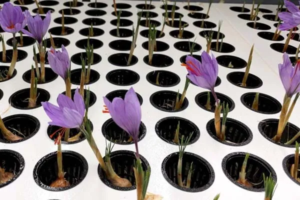What is Zajaab Irrigation?
Zajaab, a Persian term often likened to a mother replenishing after childbirth, refers to a critical irrigation stage in saffron cultivation. This specific watering method is essential for rejuvenating the saffron plant after flowering.
The Purpose of Zajaab
The primary goal of Zajaab is to replenish the nutrients depleted during the flowering stage. By applying a balanced fertilizer, especially nitrogen-rich ones like urea, we nourish the saffron plant, promoting the growth of new bulbs and ensuring a bountiful harvest in the following year.
The Purpose of Zajaab
The primary goal of Zajaab is to replenish the nutrients depleted during the flowering stage. By applying a balanced fertilizer, especially nitrogen-rich ones like urea, we nourish the saffron plant, promoting the growth of new bulbs and ensuring a bountiful harvest in the following year.
Optimal Timing for Zajaab
Zajaab irrigation is typically carried out in late November or early December, after the saffron harvest. The exact timing can vary based on regional climate and saffron variety. Look for signs such as the emergence of new green leaves and the cessation of flowering.
The Zajaab Process
Zajaab irrigation should be light, ensuring only the top layer of soil is moistened. A deep soaking is not necessary as the previous irrigation, before flowering, would have saturated the soil.
The Role of Urea in Zajaab
Urea, a nitrogen-rich fertilizer, plays a vital role in Zajaab. Nitrogen is essential for protein synthesis and overall plant growth. By applying urea, we provide the saffron plant with the necessary nutrients to recover from flowering and produce new bulbs.
The Importance of Zajaab
Saffron cultivation depends heavily on the pivotal stage of Zajaab.
The growth and development of new saffron bulbs.
The quality and quantity of the subsequent saffron harvest.
The overall health and vitality of the saffron crop.
Conclusion:
Zajaab is more than just an irrigation practice; it’s a critical component of successful saffron cultivation. By understanding the timing, purpose, and process of Zajaab, saffron farmers can optimize their yields and ensure the long-term health of their crops.







Get Social